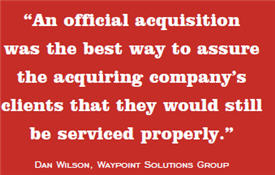Don't Settle For Managed Services Mediocrity
By Jay McCall, Business Solutions magazine
Not only is this MSP bucking the trend with 70% of its customers on a flat-fee managed services plan, it’s also projecting 29% revenue growth this year.

Just about every channel company is interested in selling managed services. After all, what’s not to like about steady income? That said, the decision to sell managed services is often met with great resistance, as N-able’s research study involving 1,800 MSPs confirms. According to their research, the average MSP has yet to convert 82% of its customers away from break-fix. Even more revealing is the fact that of the remaining 18%, most of those customers are still buying blocks of IT support, which adds an element of unpredictability to the program. Statistically speaking, there’s a good chance that your business is either currently in or about to engage in this struggle. To help you break away from managed services mediocrity, I reached out to a company that’s an outlier when it comes to selling managed services. Dan Wilson, president and CEO of Waypoint Solutions Group, recalls when his company made the decision to get into managed services. “In January 2007, we had four employees and just four clients when we decided to migrate from an outsourced tech talent company to an MSP,” says Wilson. “Today, we have 23 employees and 250 customers — 175 of which [i.e. 70%] are on a flat-rate managed services program.”
After I shared with Wilson the stats for the average MSP, I pressed him to share with me what makes Waypoint different. Following is his candid advice to any VARs considering managed services and/or MSPs stuck in break-fix ruts.
You Need The Right People To Sell Managed Services
It’s become an overused cliché to say “Our people are the key to our success.” Yet, the decision to sell managed services is often stalled due to either not having enough people or not having the right skillsets. Consider this scenario. When a break-fix reseller sells IT solutions and services, the salesperson focuses on tangible benefits such as improved productivity, reduced errors through automation, and TCO (total cost of ownership). When you’re selling managed services, on the other hand, the right approach is often more akin to selling life insurance, which emphasizes several “what-if” scenarios that hopefully will never come to pass.

Waypoint recognized this distinction early in 2007 and decided it needed to hire more techs with server and firewall skills to help it move into managed services. Wilson shared his intentions with the CEO of a competitor company, whom he had become friends with over the years. “‘Before you hire anyone, let’s talk,’ he told me,” recalls Wilson. “As it turned out, he wanted to migrate his business to managed services also, and he explained how merging our two companies would be mutually beneficial.” After a thorough due diligence and getting to know the other CEO better, Waypoint acquired the competitor, which included its 30 customers, and even brought on the former CEO as its director of services. Wilson credits two things to the successful acquisition: taking the time to get to know the key decision maker from the company he acquired to ensure they both shared a similar vision and hiring a good lawyer to put together a contract that spelled out all the details of the partnership and the operating agreement. “It’s important that everyone involved has the clarity that this person is going to be in charge of marketing, this other person is in charge of finances, and this person is in charge of operations,” says Wilson. “Doing an official acquisition was the best way to assure the acquiring company’s clients that they would still be serviced properly as opposed to our just hiring the CEO and having him dissolve his former company on his own.”
Waypoint’s acquisition paid off almost immediately. The MSP was able to convert 25 of the acquired company’s 30 clients to a managed services program right away. After it learned how to bundle its service offerings, the remaining five clients eventually converted over to managed services as well. The MSP’s first acquisition went so well, in fact, that Waypoint acquired another competitor in 2010, once again leading to new IT and managed services talent and new customers. “We picked up 60 new clients as a result of the 2010 acquisition,” recalls Wilson. “Since that time, we’ve converted all but 15 of those 60 clients to a managed services program. What typically happens is a customer decides to try it out at a very basic level [see Bronze, Silver, Gold, and Diamond level explanations in next section], and as they experience the benefits of managed services they purchase higher levels of service.” Since its second acquisition, Waypoint’s business has grown from 1,000 assets under management to more than 4,000 today.

Bundling Your Hardware, Software, And Services Is Not Optional
One of the key factors that led to Waypoint’s success in the managed services space was the decision to bundle its managed services offerings. Some MSPs wrongly think that the best way to overcome customer objections to managed services is by not putting any limitations on which IT hardware or software they’re willing to manage. But, Wilson has found the opposite to be true. “Not having limits causes multiple problems,” he says. “First, if the customer needs to purchase new IT hardware or software, it will lengthen the sales cycle as they compare all their options, and second, it makes your job as an MSP more difficult because you have to become an expert in more products and stay on top of more software patches. You also find that you lose some of the predictability that you and your customer need in a managed services offering.”
Wilson has found that most customers prefer simple solutions to their business problems. Over the past few years, Waypoint developed five bundled offerings that address various areas of its customers’ businesses: Managed IT, Security, Email, Virtualization, and Business Continuity and Disaster Recovery. Within its Managed IT bundle, which can be added to any of the technology bundles, customers do have the option as to which service level they want. Waypoint uses Bronze, Silver, Gold, and Diamond to distinguish among its services offerings. How did the MSP come up with this system? “It’s based on how our RMM [remote monitoring and management] and BDR [backup and disaster recovery] vendor, Continuum, works with us,” says Wilson. “We figured why try to reinvent the wheel when this system has already been created and works fine.”
For Waypoint’s Managed IT offering, Bronze-level support includes basic remote monitoring of agents and response to alerts. The next level up, Silver, includes help desk support. Gold customers also receive truck rolls included with their service, and the highest-level customers, Diamond, receive MACs (moves, adds, and changes) and 24/7 support on top of everything else.
 “Even though our cost to rent space in a private cloud data center and labor expenses might run about $200 per month for [a] host server, we’re still making more than $1,000 a month in recurring revenue.”
“Even though our cost to rent space in a private cloud data center and labor expenses might run about $200 per month for [a] host server, we’re still making more than $1,000 a month in recurring revenue.”
Dan Wilson, Waypoint Solutions Group
Virtualization Is The Next Phase In Managed Services Success
Within the past couple of years, Waypoint’s level-3 engineers started telling Wilson that Waypoint needed to start selling virtualization services. Wilson agreed that not only was virtualization going to represent a potential huge growth opportunity, but it also represented the next wave in managed services. “If a client wants to virtualize a server in an off-site data center or rent a virtual hosted server onpremise, it gets them out of the hardware business,” he says. “This also eliminates the $5,000 to $10,000 capital expense it incurs every three to four years in hardware update costs.”
Another benefit Wilson says that clients like about virtualization is the role it plays in improving business continuity. “Unlike the process of rebuilding a physical server, which can take days, the process of moving a virtual server to another host server takes less than 15 minutes,” he says. “We can set up a Continuum Vault BDR appliance on premise, and if the client’s primary server goes down, the Vault can spin up a live virtual server in less than 15 minutes, and it can continue to operate as a server replacement without the client experiencing any slow-downs. Even when the BDR appliance is running in virtual mode, it’s still making off-site backups to our remote data center.”
Waypoint foresees virtual desktops becoming a hot trend down the road, but says that server virtualization is a hot trend right now. “When you talk about virtualizing desktops, there are two obstacles that have to be overcome,” says Wilson. “First, you end up using all your host servers, which negates any potential hardware cost savings for the customer, and then second, you’re going to most likely have to upgrade the client’s Internet circuit, which also takes away from the cost advantages of virtualizing.”
Today, virtualization — especially server virtualization — accounts for 10% of Waypoint’s growing revenue, and the MSP expects this number to grow rapidly over the next couple of years. Even though the MSP admits that overall hardware sales are down, since it’s been selling virtual solutions to its clients, it’s still a profitable venture. “We can typically run four virtual servers on one host server,” he says. “However, a host server is equal in cost to two physical servers. In most cases we have multiple clients running on one host server, so even though our cost to rent space in a private cloud data center and labor expenses might run about $200 per month for that host server, we’re still making more than $1,000 a month in recurring revenue.”
Wilson’s final piece of advice to resellers interested in selling managed services is to avoid using terms like “managed services” with clients. “We use language that addresses their business pain points, and we let them know that we’re going to be their IT department,” says Wilson. “When a company grows to 10+ employees, there’s a good chance that it’s experiencing computer problems on a weekly basis. If you’re able to communicate to them that you’re going to be proactively monitoring all their computers and servers, and you can even solve most problems before they’re even aware of them, then 9 out of 10 times they’re going to enthusiastically sign up for your managed services offering.”

